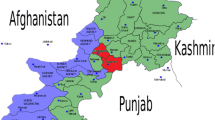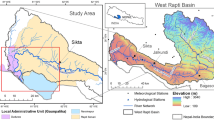Abstract
Various measures are adopted by flood-prone households for the mitigation of flood risk along with various post-flood coping strategies. We analyze the role of various ex ante household-level flood mitigation strategies in influencing riverine flood damages. The study also presents an account on the linkages of various ex post coping strategies and flood damages experienced in a flood event in Pakistan. For achieving a uniform flood damage indicator, polychoric principle component analysis (PCA) is employed to construct a composite flood damage index considering various aspects of economic, social, and psychological impacts of a flood event. The adjusted flood damage index is regressed on various socioeconomic features and ex ante mitigation actions to know their effect on the former. Results indicate that distance from river, elevating house, and pre-shifting investigating about flooding problem help in significantly reducing the overall flood damages. Likewise, group-based actions like voting political candidates based on their flood-control promises, organizing grass-root group meetings, and raising voices through memos/petitions are found to significantly reduce flood-related damages while leaving house premises before flooding is found to increase the overall flood damage. Post-flood coping strategies comprise of social and financial support along with some livelihood diversification and disinvestment strategies such as selling livestock, jewelry, and withdrawing children from schools. Borrowing money, reducing food consumption, and agricultural diversification are more prevalent strategies among low and medium damage groups while consuming savings is more conspicuous among high damage group. The study concludes with the emphasis on policy interventions for effective early warning, location-specific flood intensity information, and proper streamlining of planning process and compensation system.







Similar content being viewed by others
References
Abbas A, Amjath-Babu TS, Kächele H, Müller K (2015) Non-structural flood risk mitigation under developing country conditions: an analysis on the determinants of willingness to pay for flood insurance in rural Pakistan. Nat Hazards 75(3):2119–2135
Abbas A, Amjath-Babu TS, Kächele H, Müller K (2016) Participatory adaptation to climate extremes: an assessment of households’ willingness to contribute labor for flood risk mitigation in Pakistan. J Water Clim Change 7(3):621–−636
Abson DJ, Dougill AJ, Stringer LC (2012) Using principal component analysis for information-rich socio-ecological vulnerability mapping in Southern Africa. Applied Geog 35:515–524
Adger WN, Huq S, Brown K, Conway D, Hulme M (2003) Adaptation to climate change in the developing world. Prog Dev Studies 3(3):179–195
Akter S, Brouwer R, van Beukering PJH et al (2011) Exploring the feasibility of private micro flood insurance provision in Bangladesh. Disasters 35(2):287–307
Aryal S, Cockfield G, Maraseni TN (2014) Vulnerability of Himalayan transhumant communities to climate change. Clim Chang 125:193–208
Berman RJ, Quinn CH, Paavola J (2015) Identifying drivers of household coping strategies to multiple climatic hazards in Western Uganda: implications for adapting to future climate change. Clim Dev 7(1):71–84
Birkmann J (2011) First- and second-order adaptation to natural hazards and extreme events in the context of climate change. Nat Hazards 58:811–840
Botzen WJW, van den Bergh JCJM (2012) Risk attitudes to low-probability climate change risks: WTP for flood insurance. J Econ Behav Organ 82:151–166
Botzen WJW, Aerts JCJH, van den Bergh JCJM (2009) Willingness of homeowners to mitigate climate risk through insurance. Ecol Econ 68(8–9):2265–2277
Botzen WJW, Aerts JCJH, van den Bergh JCJM (2013) Individual preferences for reducing flood risk to near zero through elevation. Mitig Adapt Strateg Glob Chang 18:229–244
Brown JD, Damery SL (2002) Managing flood risk in the UK: towards an integration of social and technical perspectives. Trans Inst Br Geogr 27(4):412–426
Bubeck P, Botzen WJW, Kreibich H, Aerts JCJH (2012a) A review of risk perceptions and other factors that influence flood mitigation behavior. Risk Anal 32(9):1481–1495
Bubeck P, Botzen WJW, Kreibich H, Aerts JCJH (2012b) Long-term development and effectiveness of private flood mitigation measures: an analysis for the German part of the river Rhine. Nat Hazards Earth Syst Sci 12:3507–3518
Bubeck P, Botzen WJW, Laudan J, Aerts JCJH, Thieken AH (2018) Insights into flood-coping appraisals of protection motivation theory: empirical evidence from Germany and France. Risk Anal 38(6):1239–1257
Chuku CA, Okoye C (2009) Increasing resilience and reducing vulnerability in sub-Saharan African agriculture: strategies for risk coping and management. Afr J Agric Res 4(13):1524–1535
CRED (2015) EM-DAT: International Disaster Database. Centre for Research on the Epidemiology of Disasters. Universite Catholique de Louvain, Belgium
De Paola F, Giugni M, Topa ME, Bucchignani E (2014) Intensity-duration-frequency (IDF) rainfall curves, for data series and climate projection in African cities. SpringerPlus 3(1):133
De Risi R, Jalayer F, De Paola F et al (2013) Flood risk assessment for informal settlements. Nat Hazards 69(1):1003–1032
De Risi R, De Paola F, Turpie J, Kroeger T (2018) Life cycle cost and return on investment as complementary decision variables for urban flood risk management in developing countries. Int J Disaster Risk Reduct 28:88–106
Few R (2003) Flooding, vulnerability and coping strategies: local responses to a global threat. Prog Dev Stud 3(1):43–58
Grothmann T, Reusswig F (2006) People at risk of flooding: why some residents take precautionary action while others do not. Nat Hazards 38(1–2):101–−120
Helgeson JF, Dietz S, Hochrainer-Stigler S (2013) Vulnerability to weather disasters: the choice of coping strategies in rural Uganda. Ecol Soc 18(2):2. https://doi.org/10.5751/ES-05390-180202
Hirabayashi Y, Mahendran R, Koirala S et al (2013) Global flood risk under climate change. Nat Clim Chang 3:816–821
Holgado FP, Chacón S, Barbero I, Vila E (2010) Polychoric versus Pearson correlations in exploratory and confirmatory factor analysis of ordinal variables. Qual Quant 44:153–166
Immerzeel WW, Beek LPH, Bierkens MFP (2010) Climate change will affect the Asian water towers. Sci 328:1382–1385
IPCC (2007) Climate change 2007: Synthesis Report. Contribution of Working Groups I, II, III to the Fourth Assessment Report of the Intergovernmental Panel on Climate Change. Geneva, Switzerland
IPCC (2012) Managing the risks of extreme events and disasters to advance climate change adaptation: a special report of working groups I and II of the Intergovernmental Panel on Climate Change. Cambridge University Press, Cambridge (UK)
Islam MS, Hasan T, Chowdhury MSIR, Rahaman MH, Tusher TR (2012) Coping techniques of local people to flood and river erosion in char area of Bangladesh. J Environ Sci Nat Resour 5(2):251–261
Jalayer F, De Risi R, Manfredi G et al (2013) From climate predictions to flood risk assessment for a portfolio of structures. In 11th International Conference on Structural Safety & Reliability, ICOSSAR
Johnstone WM, Lence BJ (2009) Assessing the value of mitigation strategies in reducing the impact of rapid-onset catastrophic floods. J Flood Risk Manag 2(3):209–221
Kates RW (2000) Cautionary tales: adaptation and the global poor. Clim Chang 45(1):5–17
Kienzler S, Pech I, Kreibich H, Müller M, Thieken AH (2015) After the extreme flood in 2002: changes in preparedness, response and recovery of flood-affected residents in Germany between 2005. Nat Hazards Earth Syst Sci 15:505–526
Kolenikov S, Angeles G (2009) Socioeconomic status measurement with discrete proxy variables: is principal component analysis a reliable answer? Rev Income Wealth 55(1):128–165
Kreibich H, Thieken AH, Petrow T, Müller M, Merz B (2005) Flood loss reduction of private households due to building precautionary measures: lessons learned from the Elbe flood in August 2002. Nat Hazards Earth Syst Sci 5(1):117–126
Laska SB (1986) Involving homeowners in flood mitigation. J Am Plan Assoc 52:452–466
Mavhura E, Manyena SB, Collins AE, Manatsa D (2013) Indigenous knowledge, coping strategies and resilience to floods in Muzarabani. Zimbabwe Int J Disaster Risk Reduct 5:38–48
Maydeu A, D’Zurilla TJ (1995) A factor analysis of the social problem-solving inventory using polychoric correlations. Eur J Psychol Assess 11(2):98–107
Mirza MMQ (2002) Global warming and changes in the probability of occurrences of floods in Bangladesh and implications. Glob Environ Chang 12(2):127–138
Nardo M, Saisana M, Saltelli A et al (2008) Handbook on constructing composite indicators. OECD publishing, Ispra, Italy
Nepal S, Shrestha AB (2015) Impact of climate change on the hydrological regime of the Indus, Ganges and Brahmaputra river basins: a review of the literature. Int J Water Resour Dev 31(2):201–218
Pearce L (2003) Disaster management and community planning, and public participation: how to achieve sustainable hazard mitigation. Nat Hazards 28(2–3):211–228
Percy SL (1983) Citizen coproduction: prospects for improving service delivery. J Urban Aff 5:203–210
Pouliotte J, Smit B, Westerhoff L (2009) Adaptation and development: Livelihoods and climate change in Subarnabad, Bangladesh. Clim Dev 1(1):31–46
Poussin JK, Botzen WJW, Aerts JCJH (2014) Factors of influence on flood damage mitigation behavior by households. Env Sci Pol 40:69–77
Poustie MS, Brown RR, Deletic A (2014) Receptivity to sustainable urban water management in the South West Pacific. J Water Clim Chang 5(2):244–258
Rafiq L, Blaschke T (2012) Disaster risk and vulnerability in Pakistan at a district level. Geomat Nat Hazards Risk 3(4):324–341
Rahman MATMT, Islam S, Rahman SH (2015) Coping with flood and riverbank erosion caused by climate change using livelihood resources: a case study of Bangladesh. Clim Dev. 7(2):185–191
Rawlani AK, Sovacool BK (2011) Building responsiveness to climate change through community based adaptation in Bangladesh. Mitig Adapt Strateg Glob Chang 16(8):845–863
Reeve D, Badr A (2003) Performance of sandbags for domestic flood defense. P I Civil Eng- Water 156(4):341–349
Sam AS, Kumar R, Kaechele H, Mueller K (2017) Vulnerabilities to flood hazards among rural households in India. Nat Hazards 88:1133–1153
Schmidt U, Zank H (2008) Risk aversion in cumulative prospect theory. Manag Sci 54:208–216
Scoones I (1998) Sustainable rural livelihoods: a framework for analysis. Institute of Development Studies, Brighton
Shah AA, Ye J, Abid M et al (2017) Determinants of flood risk mitigation strategies at household level: a case of Khyber Pakhtunkhwa (KP) province, Pakistan. Nat Hazards 88(1):415–430
Shaw R (2006) Critical issues of community based flood mitigation: examples from Bangladesh and Vietnam. J Sci Cult 72(1–2):1–−17
Siegrist M, Gutcher H (2008) Natural hazards and motivation for mitigation behavior: people cannot predict the effect evoked by a severe flood. Risk Anal 28(3):771–778
Thieken AH, Mueller M, Kreibich H, Merz B (2005) Flood damage and influencing factors: new insights from the August 2002 flood in Germany. Water Resour Res 41(12):W12430
Thieken AH, Petrow T, Kreibich H, Merz B (2006) Insurability and mitigation of flood losses in private households in Germany. Risk Anal 26(2):383–395
Thieken AH, Kreibich H, Müller M, Merz B (2007) Coping with floods: preparedness, response and recovery of flood-affected residents in Germany in 2002. Hydro Sci J 52:1016–1037
Tversky A, Kahneman D (1992) Advances in prospect theory: cumulative representation of uncertainty. J Risk Uncertainty 5:297–323
UNHCR (2011) The WATAN scheme for flood relief: protection highlights 2010 - 2011. United Nations Human Rights Commission. http://floods2010.pakresponse.info/LinkClick.aspx?fileticket=_SpKC9jJClY%3D&tabid=206&mid=1604. Accessed 13 Dec 2014
Acknowledgments
The logistic support from Leibniz Centre for Agricultural Landscape Research (ZALF) is highly acknowledged. The valuable comments and suggestions by three anonymous reviewers are also duly acknowledged as they have substantially helped in improving the earlier version of this paper.
Funding
This research was funded by Higher Education Commission of Pakistan and German Academic Exchange Service (DAAD) while the funds for field survey were granted by Stiftung Fiat Panis, Germany.
Author information
Authors and Affiliations
Corresponding author
Additional information
Responsible editor: Philippe Garrigues
Rights and permissions
About this article
Cite this article
Abbas, A., Amjath-Babu, T.S., Kächele, H. et al. Sustainable survival under climatic extremes: linking flood risk mitigation and coping with flood damages in rural Pakistan. Environ Sci Pollut Res 25, 32491–32505 (2018). https://doi.org/10.1007/s11356-018-3203-8
Received:
Accepted:
Published:
Issue Date:
DOI: https://doi.org/10.1007/s11356-018-3203-8




